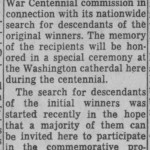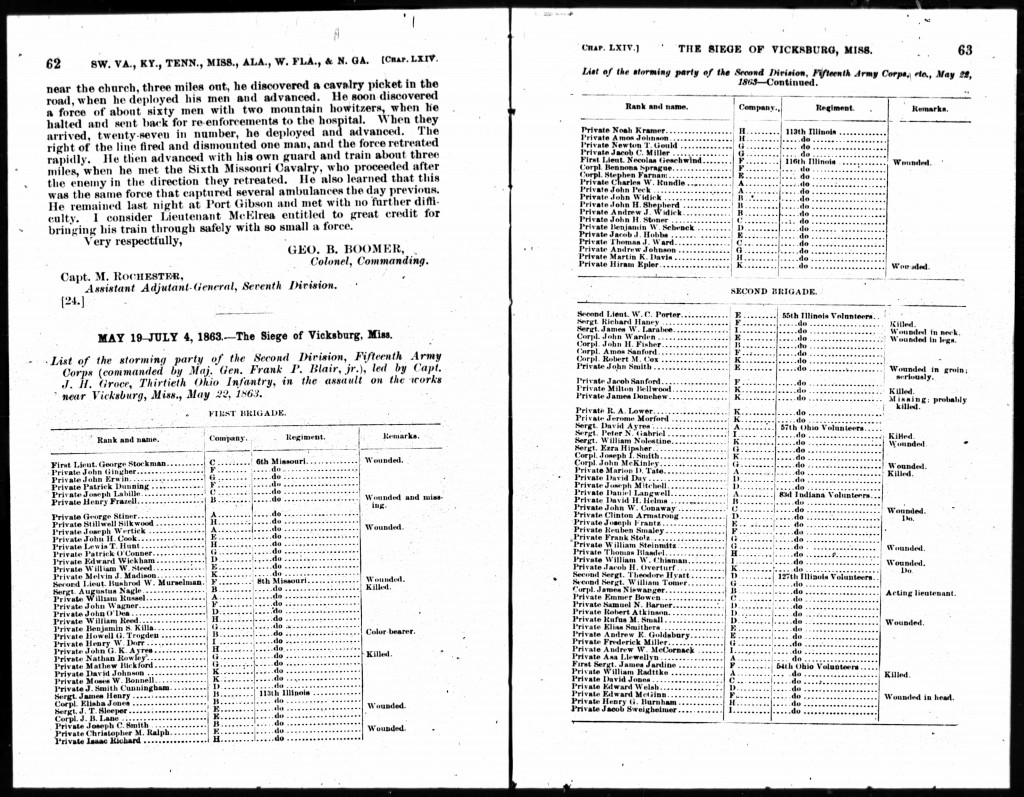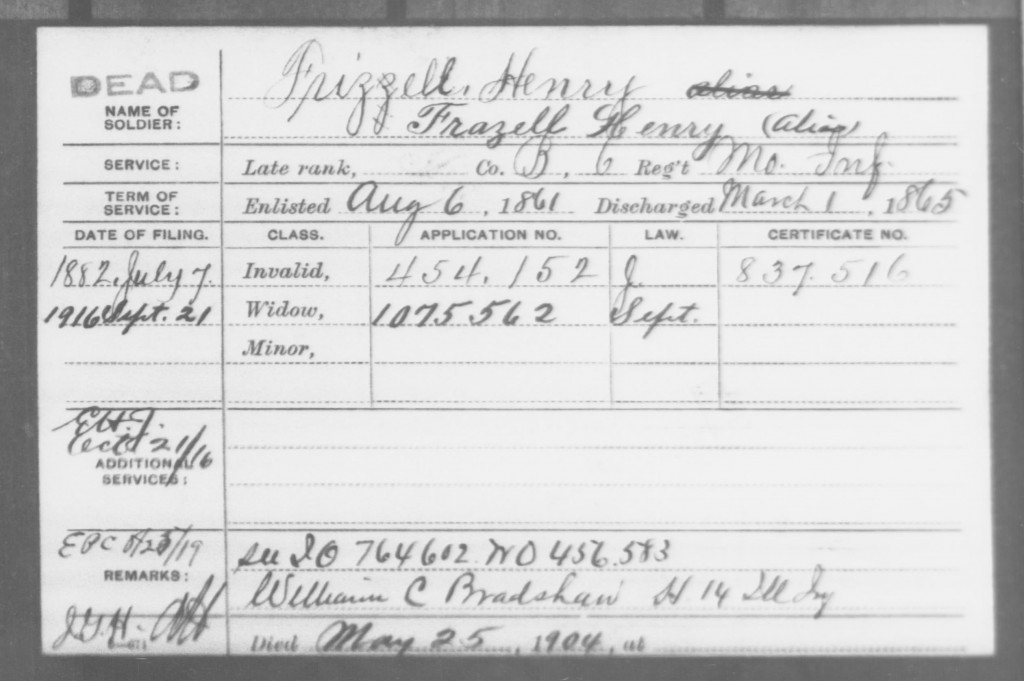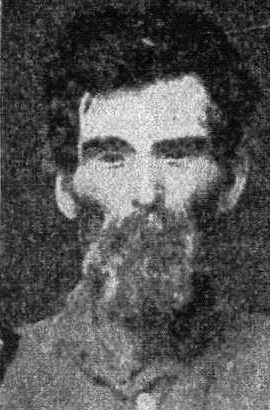
Many people already know my connection to one hero, SGT Amanda Pinson, but few are aware of another: our Great (x4) Grandfather PVT Henry Frizzell.
I study my family history and maintain a blog about my journey and research as time permits.
Knowing that we’re heading to Tennessee this summer for a family vacation I knew that a stop that I wanted to make along our destination was Chattanooga/Lookout Mountain.
You see, Henry was a fascinating man. A brave, fascinating man. His story often goes untold as he was sort of lost in the shuffle during his service years in the Union Army during the Civil War.
I’ll let the story about him, written by the Daily Journal’s Sherry Greminger, tell you more about that. However, ever since my cousin, Charles Dalton, told me about Henry I became fascinated and made a vow to share Henry’s story.
In order to tell it, I felt I should learn as much about it as I can. But first, read the first two articles below so it will make more sense…
AN UNKNOWN HERO TO BE HONORED MONDAY — MADISON COUNTY PAYS TRIBUTE TO CIVIL WAR MEDAL OF HONOR RECIPIENT
By SHERRY GREMINGER\Daily Journal Managing Editor
The DAILY JOURNAL
Friday, May 26, 2006 FREDERICKTOWN
For more than 100 years, a hero lay buried in St. Louis unknown to his family and unknown to his community. Although a stone at Mount Lebanon Cemetery on St. Charles Rock Road marks his grave site, no one’s really sure the remains of Henry Frizzell are there. Monday, this man who died a pauper in St. Louis in 1904 will be honored here as Madison County’s only recipient of the Congressional Medal of Honor.
Finally his family and community will have the opportunity to pay respects to this Union soldier who labored so hard to get his military record cleared and to eke out a meager life for himself and his family in the years following the Civil War.Frizzell’s great-great-grandson Charles Dalton, of St. Louis, and his two uncles Michael Sutton of St. Louis and David Sutton of Cuba, Mo. will be in Fredericktown Memorial Day to honor their ancestor. Dalton said his son might also be there – representing yet another generation who will finally be able to pay tribute to their family’s war hero.
The Medford McClanahan American Legion Post 248 will hold a dedication ceremony at 11 a.m. Monday on the south lawn of the Madison County Courthouse to dedicate a monument to Frizzell, as the county’s only Medal of Honor recipient.
Dalton said Frizzell died of consumption May 25, 1904 at City Hospital and because he was a pauper he was buried in Potter’s Field. His remains have since been moved twice and now supposedly rest in Mount Lebanon Cemetery on St. Charles Rock Road. When the city sold the ground at Potter’s Field in 1957, all remains were moved to Mount Lebanon Cemetery.
“When they sent the remains to the cemetery, there were no names or markers to accompany them. All of the remains were put in one section of the cemetery. That land was also later sold and the remains were moved to Section F in the cemetery,” Dalton said.
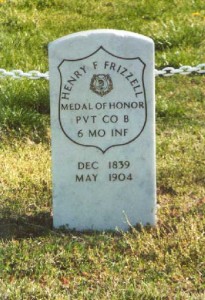 According to Dalton a marker was dedicated to his ancestor in 1991. The ceremony was sponsored by the Medal of Honor Historical Society and the Veterans Administration provided a headstone etched in gold. Dalton said it was placed at the front of the cemetery because no one was exactly sure where his remains might be.When Frizzell was buried, there is no indication any of his family was present. One thing, however, is certain – those burying him did not know Frizzell, the man, or Frizzell, the hero.
According to Dalton a marker was dedicated to his ancestor in 1991. The ceremony was sponsored by the Medal of Honor Historical Society and the Veterans Administration provided a headstone etched in gold. Dalton said it was placed at the front of the cemetery because no one was exactly sure where his remains might be.When Frizzell was buried, there is no indication any of his family was present. One thing, however, is certain – those burying him did not know Frizzell, the man, or Frizzell, the hero.
HENRY FRIZZELL – THE MAN —
The attack on Fort Sumter in 1861 coupled with the promise of pay and food to eat were enough to entice a 21-year-old farmer from Fredericktown to join the Union Army. Henry Frizzell went to Pilot Knob on Aug. 6, 1861, and enlisted as a private in Company B, 6th Missouri Infantry. Henry was not a tall man, 5 feet, 6 inches. Through letters written for him, a picture emerges of a fair-haired, gray-eyed man who was born and raised on the Big St. Francois River.
He was born into a poor family and his parents, Jason and Odeel (Smith) Frizzell could neither read nor write. Henry reports in letters written for him that there were no schools for him to attend, so he could not read or write himself. Henry tells of being wounded several times. He was captured twice by Confederates and worked for many years following the end of the Civil War to have desertion charges expunged from his record.
According to historical accounts from the time of Henry’s enlistment, the 6th Missouri Infantry was in the thick of many battles and traveled from Springfield, Mo. in October of 1861 to Vicksburg, Miss., in 1863 where they joined the assault on the last Confederate stronghold on the Mississippi River. It was for his actions during this assault that the Medal of Honor was bestowed upon him.He was shot in the right side of his head just below his right eye as he made an assault on Fort Hill. He was captured by the Confederates and spent one week in their hospital. He was then paroled and sent to the Jeffersonville, Ohio hospital, where he spent two months.
FORLORN HOPE: VOLUNTEER STORMERS –
Frizzell was a member of a group nicknamed “Forlorn Hope: Volunteer Stormers.”A book “Deeds of Valor: How America’s Civil War Heroes Won the Congressional Medal of Honor” published in 1903 recounts in detail the deeds of the Volunteer Storming Party of Vicksburg.According to the book, this group, made up entirely of volunteers, led the general assault on Vicksburg on May 22, 1863. The assault was thought to be so dangerous that Union Commander Gen. Ulysses S. Grant would not allow married men to volunteer.
Grant had underestimated the strength of the Confederates and although he had the city circled on three sides with a 12-mile battle line and warships stationed on the Mississippi, things were not going well for the Union general wanting to avoid a lengthy siege, Grant decided to storm the city. The Confederates had dug in along the top of a bluff and Grant chose a portion of that bluff which was to the south of Fort Hill. This fort in addition to being almost perpendicular, was protected by a ditch about 12 feet wide and 5 or 6 feet deep and sloping up toward the enemy’s guns.It was estimated the storming party needed at least 150 men. Twice that number answered the call, with those volunteering first being accepted.The battle plan was formulated. The men were to build a bridge over the ditch and plant scaling ladders against the embankment. By the time they had accomplished this feat, it was expected the supporting brigades would be ready to make the final assault.
THE ASSAULT —
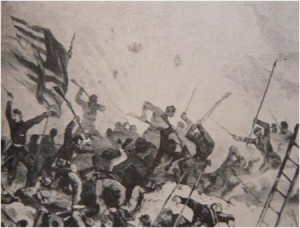 On the morning of May 22, 1863, the storming party gathered in a ravine out of sight of the Confederates. Here they had a pile of logs, lumber and scaling ladders. The advance party’s job was for two men to carry the logs, run toward the trench and throw them across the ditch to form the basis of a bridge. The second group was to follow closely with the lumber to throw across the logs. The third group was to bring the ladders, run across the bridge and place them against the fort.
On the morning of May 22, 1863, the storming party gathered in a ravine out of sight of the Confederates. Here they had a pile of logs, lumber and scaling ladders. The advance party’s job was for two men to carry the logs, run toward the trench and throw them across the ditch to form the basis of a bridge. The second group was to follow closely with the lumber to throw across the logs. The third group was to bring the ladders, run across the bridge and place them against the fort.
From minute one, things did not work out well for the “forlorn hope.” Enemy fire was so heavy that as they advanced at a dead run, about half of them were shot down and the area was thick with smoke.
When the survivors did arrive at the ditch, they could not make a bridge because so many logs and pieces of lumber had been dropped. They also discovered they could not stay where they were because of heavy enemy fire.
Historical accounts relate the survivors jumped into the ditch and Private Howell G. Trogden who carried the storming party’s flag planted it on the parapet of the fort. Trogden kept firing at the enemy when they tried to reach the flag.
Other brigades advanced to support the small group of men, but only 30 men, those of the 11th Missouri reached them. They planted their flag and dug in wherever they could find shelter. It was reported the bottom of the ditch was filled with mangled bodies with heads and limbs blown off.
The assault had plainly failed, but the men in the ditch could neither retreat nor advance. They held their position until, under the cover of darkness, they were able to leave. Of the storming party, 85 percent were killed and there were only a few who escaped without a wound of some kind.
In the fighting that followed, the Union suffered more than 3,000 casualties and 97 Union soldiers earned Medals of Honor (the second largest single-day total in history).
The following Missouri men who survived the siege of Vicksburg were recognized by their country with the Medal of Honor: John Ayers, 8th Missouri Infantry; Matthew Bickford, 8th Missouri Infantry; James Cunningham, 8th Missouri Infantry; James Flynn, 6th Missouri Infantry; Henry Frizzell (Frazell), 6th Missouri Infantry; Louis Hunt, 6th Missouri Infantry; David Johnston, 8th Missouri Infantry; George Stockman, 6th Missouri Infantry; Howell Trogden, 8th Missouri Infantry; John Wagner, 8th Missouri Infantry; Joseph Wortick, 8th Missouri Infantry.
DESERTION CHARGES FILED —
A letter written by a friend in Fredericktown found in his Medal of Honor file reported Frizzell believed his regiment was in Alabama when he rejoined it after being released from the hospital following the siege of Vicksburg. He does report in letters that he fought at the battle of Chattanooga, Tenn. on Lookout Mountain.
With his regiment now under the command of General William Sherman, he continued in the March to Atlanta and was shot in the left leg above the knee at the battle of Resaca Georgia and went to the hospital. He rejoined his unit and remained with it though Georgia and Carolina until March of 1864.
On March 1, 1864, at Lynchcreek, North Carolina, Frizzell ended his war years. He went with a friend to a house to rest and was captured by enemy forces. He escaped from the Confederates and thinking the war was over, began his long trek home. This move resulted in desertion charges being brought against him.
In letters written for him to help get the charge removed from his military record, he tells of being tired, confused and captured.
In a letter written Feb. 18, 1891, Frizzell tells how Andy Harness, who was in the same regiment with him persuaded him to go to a private home where they could get some rest. He said Harness convinced him that the “Rebels were whipped and the war would soon be over.”
While they were resting at the home, they were captured by Confederates. They did escape, but their regiment had moved north and with Confederates everywhere, Frizzell is quoted as saying, “It was impossible to rejoin the unit.”
It is reported that everywhere they went they kept hearing that the war was over, so he just started working his way back to Madison County.
Another letter states, “My head hurt and my left leg, which had been wounded, gave out.”
The author of the letter wrote that Frizzell said he only went to the home with Harness because he was not well and was completely worn out. The writer said Frizzell told him that since being wounded at Vicksburg, his memory had been bad and he “cannot recall important things to family and myself. I am satisfied that at times I am not in my right mind. I was laboring under this state of mind when I left my command.”
Several more letters, most written in February of 1891, attested to Frizzell’s good character, but alluded to mental problems probably caused by his injures suffered at Vicksburg.
One letter written by Jonathan Williams said, “After the war he has been of weak mind, almost like an idiot and hardly of a mind to care for himself. He is very poor and destitute and the only support is from what little labor he can do.”
Yet another letter, written by Fielding King who enlisted in the 6th Regiment with Frizzell said, “Henry was shot on the side of the head cutting his ear and corner of the right eye at Vicksburg. When he rejoined the regiment, he never appeared to be entirely himself. He never would have left, with Andrew Harness, on his own accord. He was a good soldier, he never shirked his duty nor tried to keep out of battle. He returned to Madison County in September of 1865.”
Thomas Hollday (sic) stated that he had know Frizzell since childhood and aided him as he could. He said he paid for all the cost for postage and affidavits because “he is very poor, illiterate and ignorant. His mind is weak and memory bad but he is a good citizen.”
AN HONORED VETERAN —
All these letters must have helped because in a letter dated March 31, 1891, the War Department removed the charge of desertion from his record.
The last letter in Frizzell’s Medal of Honor file is one dated June 30, 1894 which says that he had been awarded a Medal of Honor medal which would be forwarded by mail.
This letter stated, “I have the honor to inform you that… By direction of the President, and without solicitation from any source – the award being based solely upon the official records – let a Medal of Honor be presented to Private Henry F. Frizzell, Co. B, 6th Missouri Infantry, for most distinguished gallantry in action at Vicksburg, Miss., May 22, 1863.
“The soldier was a member of a volunteer storming party which made a most gallant assault upon the enemy’s works. Signed: Joseph B. Doe, Asst. Secretary of War.”
None of his living descendants know what happened to that medal, nor how Frizzell ended his life destitute in St. Louis.
But on Memorial Day, none of that will matter. A hero will be honored and members of his family and community will be witness to the ceremony.
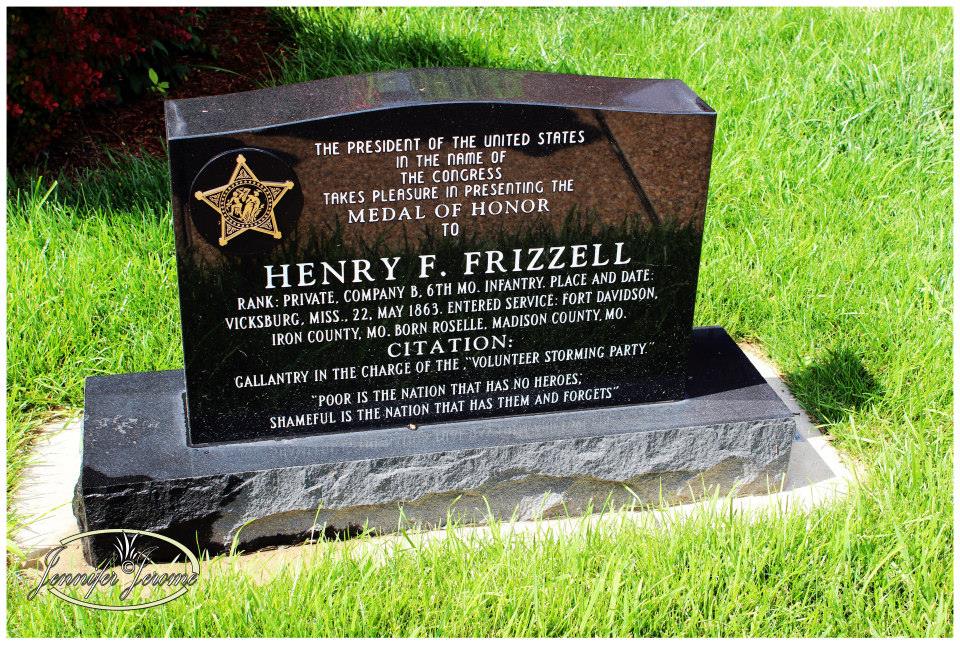
The DAILY JOURNAL, Friday, May 26, 2006
The Vicksburg campaign was waged from March 29 to July 4, 1863. It included battles in west-central Mississippi at Port Gibson, Raymond, Jackson, Champion Hill, Big Black River and numerous smaller battle fields. On the morning of May 22, General Grant launched what he hoped would be a crushing assault against Vicksburg. In the fighting that followed, the Union Infantry was repulsed and thrown back along a three-mile front. The Union Army suffered more than 3,000 casualties, and 97 Union soldiers earned Medals of Honor (the second largest single-day total in history.)
Private Henry Frizzell was one of eighty soldiers cited simply for “Gallantry in the charge of the ‘volunteer storming party,’ seemingly innocuous wording that actually denotes the fact that Private Frizzell was at the head of his attacking force where the enemy fire was hottest and the danger the greatest. Following the failed assault on May 22, a forty-seven day siege was laid against the city, which finally surrendered to Union forces on July 4.
HENRY F FRIZZELL was born Dec 1837 in Area of Silver Mines on Big St Francois River, Madison County Missouri, and died 25 May 1904 in Temporary City Hospital, St Louis, Missouri. He married REBECCA SINCLAIR 1869 in Madison Co. Missouri, daughter of WILLIAM ST. CLAIR and WILEY JOHNSON. She was born 17 Jan 1849 in Madison County Missouri, and died Abt. 1889 in Madison County Missouri. He married SARAH ELLEN CARMACK 11 Oct 1893 in Madison Co. Missouri. She was born 05 Jun 1850 in Madison County Missouri, and died 16 Feb 1924 in Fredericktown, Madison Co. Missouri.
Notes for HENRY F FRIZZELL: Henry was buried in St Louis City’s Potter’s Field in 1904. It was located at Sublette & Fyler which is now the site of the Hampton Gardens Apartments. In 1957 Potter’s Field was moved to Mount Lebanon Cemetery at 11101 St Charles Rock Road. There were no records or markers with the remains received from the City. They were buried at about Cypress and Hunter Drive. In 1995 when the cemetery sold this land, all remains were moved to a a mass grave in Section F graves 450 & 452 in same cemetery. The area sold is now the parking lot for Hunter Engineering.
On May 26 1991 a marker was placed in Section N by the Medal of Honor Historical Society to honor Henry as a Congressional Medal of Honor recipient. Sonny Wells of the Medal of Honor Historical Society did the research on Henry and gave the information to the Veterans Administration which provided the head stone etched in gold.
Sonny also arranged the ceremony and Geraldine Sanders Smith gave a speech about Henry. Being that the exact location of his remains were unknown, the Marker was placed in the front of the Cemetery. Henry was shot in the Battle of Vicksburg Mississippi on the outside of his right eye breaking bone, causing vision problems and removing part of right ear. Battle was on May 22, 1863.
He was wounded again in the Battle of Resaca Georgia during May 14, 1864. His wound was a gunshot 2 inches above his left knee.
Letter to: Henry F. Frizzell, Fredericktown, Mo. dated July 30, 1894:
I have the honor to inform you that by the direction of the President, and without solicitation from any source – the award being based solely upon the official records – let a Medal of Honor be presented to Private Henry F. Frizzell, Co. B 6th Missouri Infantry, for most distinguished gallantry in action at Vicksburg, Miss., May 22, 1863. This soldier was a member of a volunteer storming party which made a most gallant assault upon the enemy’s works. signed Joseph B. Doe, Asst. Secretary of War Pvt.
Henry Frizzell is the only person from Madison Co. Mo. to be awarded this esteemed medal, sometimes now called Congressional Medal of Honor. There have been only 3,461 medals awarded from 1862 to 2006, of which 77 were given to people from Missouri.
He received the medal through the mail and signed for it at the post office, in Fredericktown, on 2 Aug. 1894. When the Cyclone of 1896 destroyed the city hospital on Lafayette Avenue the patients were transferred to Emergency Hospital 1. This was the Convent of the House of Good Shepherd located on the block bounded by 17th, 18th, Pine and Chestnut Streets.
By 1901 the hospital became so overcrowded the city purchased the Pius Hospital at 14th and O’Fallon to be Emergency Hospital 2. Number 2 hospital was used for patients with Communicable Diseases. Both was used until August 10, 1905 when the new hospital on Lafayette Avenue was completed. Because Henry died of Consumption, also called TB, I do not know which hospital he may have died in.
On May 29, 2006 the American Legion Post 248 dedicated a monument, on the south lawn of the Fredericktown Courthouse, in honor of Henry Frizzell. They raised the money for the monument from people and businesses around Fredericktown.
Speeches were given by Kent Kooi, from the Medal of Honor Historical Society, and Charles Dalton on behalf of Henry’s descendants. 10 descendants representing 4 generations were present. Mayor Karen Yates welcomed evereyone and Donnie Owens who started the idea was master of ceremony. Geraldine Sanders Smith, who spoke at 1991 ceremony was present but did not speak.
More About HENRY F FRIZZELL:
Burial: 1957, Mount Lebanon Cemetery, St Louis Missouri
Burial permit Issued: 29 May 1904, City of St Louis Mo.34
More About HENRY FRIZZELL and REBECCA SINCLAIR:
Marriage: 1869, Madison Co. Missouri
Notes for SARAH ELLEN CARMACK: After her 2nd husband died in 1890 she started writing for his pension. She never received his pension because she never proved that she divorced her 1st Husband.The War Department sent several letters explaining that the needed proof that she divorced her 1st husband before she married William Bradshaw. They said she was not the legal wife of Bradshaw. After Henry, her 3rd husband, died she started writing for his pension which she never got because she married him after the Act of 1890 was passed. Several times they sent hers letters that she was not entitled to his pension and why. She first started writing letters herself then got 3 lawyers and finally one person from Fredericktown to also write and try to get either pension. I think she went to each person and after they got the answer that she was not entitled and told her so, she went and found someone else. Her last attempt was in 1918 and I guess it finally sunk in or she could not find anybody else to try. In 1881 in Madison Co. Mo. there is a divorce of a Nathaniel Martin and Sarah Martin. Sarah’s 1st husband was Nathaniel Martin who she stayed with only 3 days after marriage in June 1880.
What I’ve learned since:
Amanda (my cousin, also his Great(x4) Granddaughter) was honored the same day that he was. She was being honored in Maryland at the National Security Agency as he was being honored in Fredericktown, Missouri. The odds intrigued me. Where else has that possibly taken place before?
On Sunday, July 19, 1959 the government were searching for descendants of Henry Frizzell, through The Kansas City Star newspaper, as he was being honored during a Civil War centennial tribute and they requested his descendants presence (see image to the left)
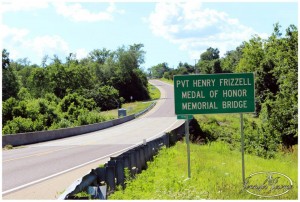 On April 9, 2010 they named a bridge in his honor in St. Francois County, Missouri.
On April 9, 2010 they named a bridge in his honor in St. Francois County, Missouri.
I have found a few of Henry’s military records available through research and various resources. In the one below you will see where they list him as “Wounded and Missing” after the Battle of Vicksburg. He’s the 6th name, on page 62.
Since this time I have also discovered that his picture was shown in a book titled, “Deed of Valor – How America’s Civil War Heroes Won the Congressional Medal of Honor”. His picture is on the 2nd image, top right. I now own a copy of this book that will no doubt be passed down generation after generation.
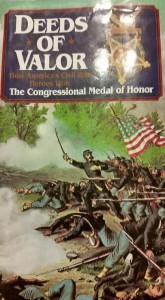
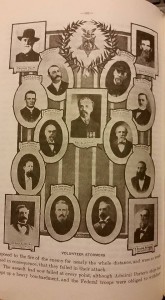
To summarize the story of Henry Frizzell and bring our trip to Chattanooga into perspective I sent an email to the Chickamauga & Chattanooga National Military Park and asked them how I might learn more while visiting. A very nice Park Ranger by the name of Chris Barr responded to me. His response was very intriguing and I can’t wait to visit and literally walk in my Great Great Great Great Grandfather’s footsteps…and yes, I did exactly as he suggested and ordered Henry’s military records in case I’m missing anything important 🙂
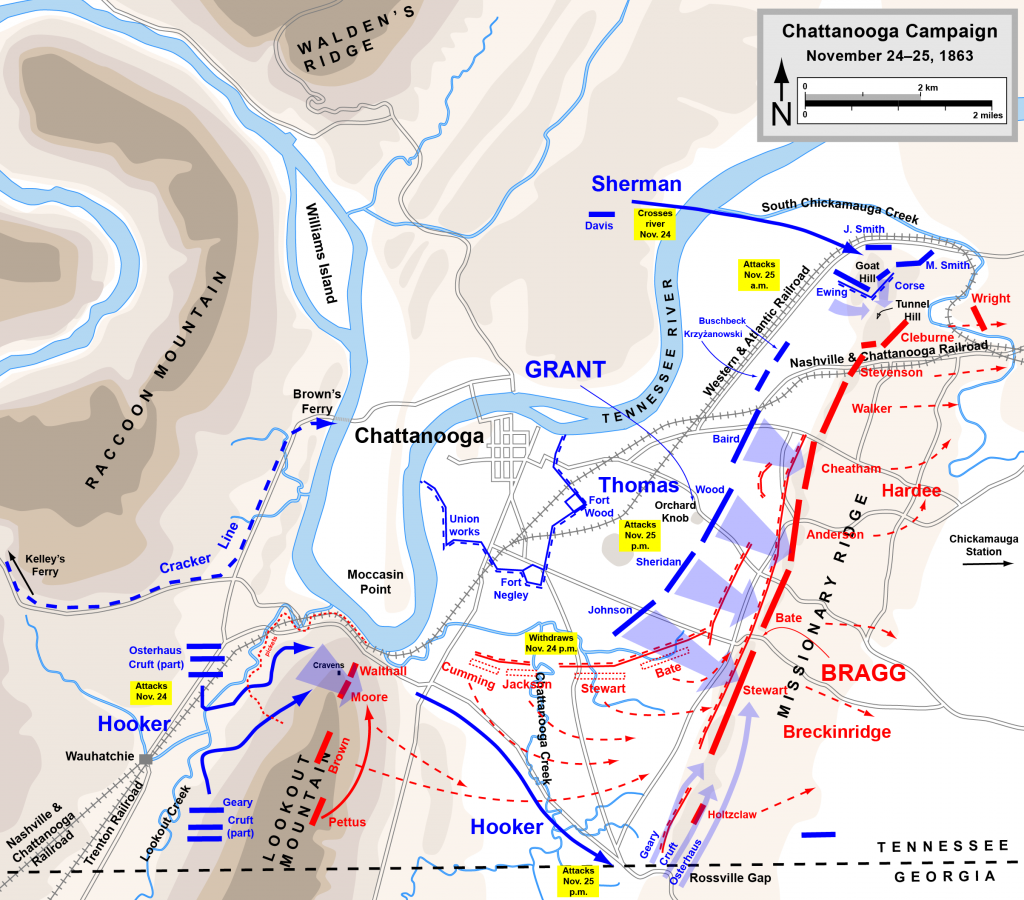
Map attached to email
After this vacation my next stop is Vicksburg. To learn more about it, watch this amazing video completed by Vicksburg National Military Park. It made me feel SO proud to be related to such a brave and honorable man who was shot in the head during this well known battle and lived to tell about it.

